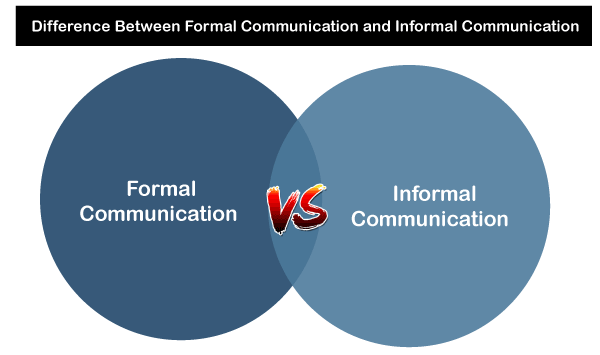Difference between Formal and Informal CommunicationCommunication plays an essential role in our lives. One needs to have good communication skills in order to excel in any field. On an organizational level, communication is of utmost importance. People exchange their ideas, opinions, perceptions with one another through communication. Communication can be oral/ verbal, or written. Oral communication includes speaking out, talking to each other regarding different things, while written communication includes writing down or penning a letter in order to communicate with the person. Sign language is also a part of communication wherein people use various signs and symbols in order to converse with other people. Body language, eye contact, expressions, etc., are important aspects of communication. So, today we will be discussing two significant types of communication, i.e., formal communication and informal communication. Let us begin by understanding the primary meaning of the same. 
Formal CommunicationFormal communication is defined as the communication in which the information is reached through proper channels or routes. It is also called official communication. The main aim of this communication is to properly converse and making sure that the information has reached correctly. This communication is considered as an effective communication mode as it saves time through its systematic flow of communication. Examples of formal communication include reports, post descriptions, work command, information related to sales and inventory, etc. There are four kinds of formal communication, i.e., upward communication, downward communication, vertical communication, and horizontal communication. The superior and the subordinate conversation comes under formal communication. One of the major disadvantages of formal communication is that rules and regulations are very rigid. More importance is given to the rules; instead of the person. It results in low cordiality among relationships between the superior and subordinates. Informal CommunicationInformal communication is defined as communication that does not undertake formal methods to communicate. People/ subordinates do not follow the rigid rules of the organization. People converse freely without any bondage. On an organizational level, informal communication is the spontaneous kind of communication in which the subordinates and the superior can talk freely. There are no official rules, systems, or guidelines to communicate. Talking to your friend or family is a common example of informal communication. One of the major advantages of informal communication is that it is very flexible. There is no rigidity or any kind of formality to hinder the communication. Grapevine communication is a significant kind of informal communication. The disadvantage of this kind of communication is that rumors or misinformation spread at a rapid pace. Now, let us look at some of the differences between formal and informal communication.
So, these are some of the significant differences between formal and informal communication. Both kinds of communication are practiced by several organizations. The main goal of this is to meet the organization's and personal objectives. Now, there are several types of formal and informal communication. So, let us discuss them. Types of Formal Communication
Types of Informal Communication
So, these are the significant kinds of formal and informal communication. To create a better environment and achieve the company's goals, both types of communication are required. The morale of the employees is boosted and the organization also fulfills its objective. Both formal and informal communication goes hand in hand. Thus, for smooth and efficient working of the organization, both formal, and informal communication is necessary.
Next Topic#
|
 For Videos Join Our Youtube Channel: Join Now
For Videos Join Our Youtube Channel: Join Now
Feedback
- Send your Feedback to [email protected]
Help Others, Please Share










